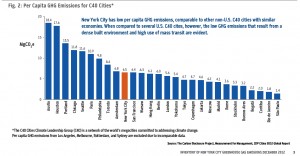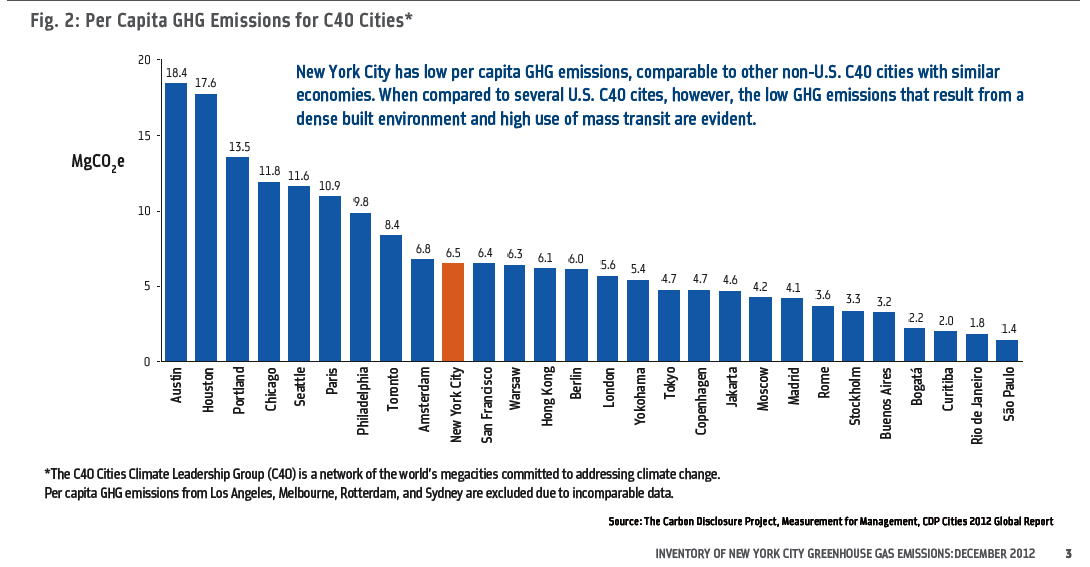The Kyoto Protocol, adopted in 1997, was an international agreement by sovereign nation states to commit to legally binding emissions reduction targets. While this was a big step forward for climate change governance, it did not bind all countries in the world to reduce their global emissions, only certain developed countries, because it was argued that developing countries were not responsible for the current problem and did not have the infrastructure to implement mitigation efforts. But in recent years, the GHG emissions of developing countries have surpassed those of developed countries. For example, in 2008 China was the top emitter of any country in the world, with India in third. And the US, the most powerful country and the 2nd largest GHG emitter in the world, did not join the Kyoto Protocol and is not bound by it (Global Emissions). Furthermore, nation-states are often limited as to how directly they are able to influence carbon emissions in their country. Much of the time, it is non-state actors, such as multinational corporations or individual consumers, that most directly influence the amount of carbon emissions (Bulkeley and Newell 8).
As people began to realize some of the failures and limitations of the Kyoto Protocol and the UNFCCC, they began to form non-state organizations and networks working across borders to mitigate and adapt to climate change. Municipalities, provinces and corporations formed various transnational governance organizations and networks to try and influence international governance and promote change at the community level (Bulkeley and Newell 54). One of these transnational networks is the Climate Alliance and was actually formed before the Kyoto Protocol went into effect (Bulkeley and Newell 55). The Climate Alliance has been very effective in advancing its objectives and reaching its goals. It has contributed to the exchange of information about local climate policy, coordinated projects devoted to indigenous rights, and has prompted CO2 emissions reductions in numerous European municipalities (Welcome).
The Climate Alliance, officially called The Climate Alliance of European Cities with Indigenous Rainforest Peoples, was created in 1990 and consists of 1,700 cities, municipalities and districts. It is partnered with the Coordinating Body for the Indigenous Peoples Organization of the Amazon Basin (COICA). COICA represents the interests of indigenous peoples in the functions of the climate alliance (Climate Profile).
The Climate Alliance was formed for the main purpose of supporting indigenous peoples and their rights in the Amazon Basin. The organization goes about this is in a variety of ways, one of which is by calling for ratification of ILO Convention No. 169, an international norm put forth by the International Labor Organization guaranteeing the legally binding protection of the basic rights of indigenous peoples. The alliance also participates in the ad-hoc working group formed at the 4th Conference of the Parties to the Convention of Biological Diversity, which addresses issues surrounding the preservation of “traditional knowledge, innovations and practices of indigenous peoples”, and “respect[ing], preserv[ing] and maintain[ing] the sustainable use of biological diversity (What is the ILO?, Convention). European members of The Climate Alliance also bind themselves to certain greenhouse gas emissions reductions, support dialogues among indigenous peoples and governments and corporations, and abstain from the municipal procurement of tropical timber derived from destructive logging, and support other policies and measures for the protection of tropical rainforests and biodiversity (Our Objectives). Also, if the association for whatever reason dissolves, the funds, instead of going to states, serve non-profit purposes and goes to support projects in rainforests (Article 2). In the more political sphere, the Climate Alliance represents member European municipalities in events organized by the European Commission, and also influences decisions made by the EU institutions to strengthen the role of local authorities in climate change policy (European Policy).
In action, The Climate Alliance has been very effective in implementing many of its ideals. It has supported a project for the assembly of mobile solar lamps and modules, which will replace petroleum lamps in the Peruvian rainforest. This will not only help to cut down on CO2 emissions and health problems resulting from the petroleum lamps, but also improve the living conditions of indigenous communities and support renewable sources of energy (Solar Partnerships). Other things the climate alliance has done include representing both European municipalities and indigenous organizations in international forums, such as the UNFCCC, and working to secure indigenous rights surrounding such areas as reforestation measures and providing legal aid for indigenous organizations under attack from logging companies and oil corporations (International Policy, Cooperations and Projects). The most obvious instances of this happening are in Sarayaku, Ecuador, when The Climate Alliance provided legal aid and advice to the community after the government attempted to partition the community’s land between various oil companies. Protests and resistance from the community halted drilling, and there are currently ongoing debates over land and mining rights, although in 1998 the constitutional court recognized that “oil exploitation violated the rights of indigenous peoples” (Sarayaku). In the realm of reforestation, The Climate Alliance has raised awareness in indigenous groups, including COICA, about the dangers of these reforestation efforts, and subsequently disseminated information and held seminars for indigenous peoples to prepare for upcoming climate talks about the issue (Indigene Peoples).
The Climate Alliance also provides an information exchange about tools and recommendations for local climate policy through conferences and publications, and also showcases its members’ achievements in various databases (climate alliance activities). In the realm of CO2 emissions in European municipalities, a lot of good progress has been made. Liepzig, Germany has reduced its tons of C02 emission per resident from 11,315 tons in 1990 to 6,150 tons in 2005, a reduction of almost half. Langenegg, Austria is currently meeting the heating demand of municipal buildings 98.5% through renewable resources (Germany). Other municipalities have made great progress also, and all municipalities in the Climate Alliance have pledged to cut their per capita emissions by half by 2030 (Our Objectives).
In the aftermath of the Kyoto Protocol, many transnational organizations and networks, including The Climate Alliance, sprang up in reaction to perceived failure within the Protocol and the UNFCCC. The Climate Alliance, an organization dedicated to the protection of the world’s climate and indigenous rights in the Amazon Basin, has been effective in advancing its objectives and picking up the slack from international climate governance between nation states. It has protected indigenous communities from destruction by oil corporations and loggers and reduced GHG emissions in both Europe and the Amazon, all while promoting information exchange between municipalities about local climate policy. This shows that transnational networks and organization can be very useful in supporting and informing policy at the local level, which is important because this is one of the most important levels for behavior and policy change to happen. If effective climate policies are wanted, community involvement is necessary, because they are able to work on a more manageable scale and are able to understand local circumstances and obstacles to policy change better than a representative working at the national or international level (Bulkeley and Newell 73).
Works Cited
Bulkeley, Harriet, and Peter Newell. Governing Climate Change. London: Routledge, 2010. Print.
The Climate Alliance. “Article 2: The Purpose of the Association.” Statutes. Proc. of Assemble of 30th March, 1992. Frankfurt Am Main: European Secretariat. Statutes. The Climate Alliance. Web. 30 Sept. 2014.
“Climate Alliance: European Policy.” The Climate Alliance. The Climate Alliance, 30 Sept. 2014. Web. 30 Sept. 2014.
“Climate Alliance: Our Profile.” The Climate Alliance. The Climate Alliance, 30 Sept. 2014. Web. 30 Sept. 2014.
“Convention on Biological Diversity (CBD).” Indigene: Biodiversity. The Climate Alliance, 9 Aug. 2014. Web. 30 Sept. 2014.
“Cooperations and Projects.” Indigene: Cooperations and Projects. The Climate Alliance, 9 Aug. 2014. Web. 30 Sept. 2014.
Germany. German Ministry. German Agency for the Environment. Future Café: Milestones in Local Climate Protection. The Climate Alliance. The Climate Alliance. Web. 30 Oct. 2014.
“Global Emissions.” EPA. Environmental Protection Agency, 9 Sept. 2013. Web. 29 Sept. 2014.
“Indigenous Peoples in the International Climate Process.” The Climate Alliance. The Climate Alliance, 9 Aug. 2014. Web. 30 Sept. 2014.
“International Policy.” Climate Alliance:. The Climate Alliance, 30 Sept. 2014. Web. 30 Oct. 2014.
“Our Objectives.” Climate Alliance: Our Objectives. The Climate Alliance, 30 Sept. 2014. Web. 30 Sept. 2014.
“The Sarayaku Community Needs Juridical Support.” The Climate Alliance. The Climate Alliance, 9 Aug. 2014. Web. 30 Sept. 2014.
“Solar Partnerships – Solar Lamps in the Peruvian Rainforest.” Indigene: Solar Lamps. The Climate Alliance, 9 Aug. 2014. Web. 01 Oct. 2014.
“Welcome to the Website of Climate Alliance!” Climate Alliance: Home. The Climate Alliance, 30 Sept. 2014. Web. 30 Sept. 2014.
“What Is the ILO?” Indigene: ILO 169. The Climate Alliance, 9 Aug. 2014. Web. 30 Sept. 2014.





